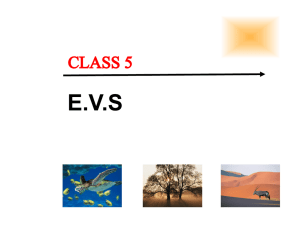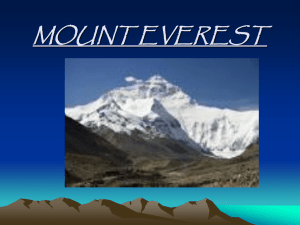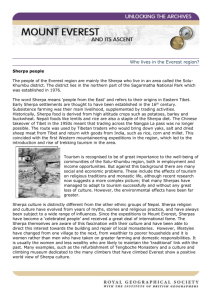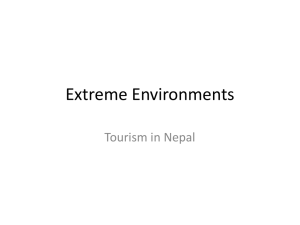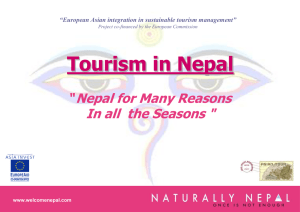Mountain Waste management and effects of
advertisement
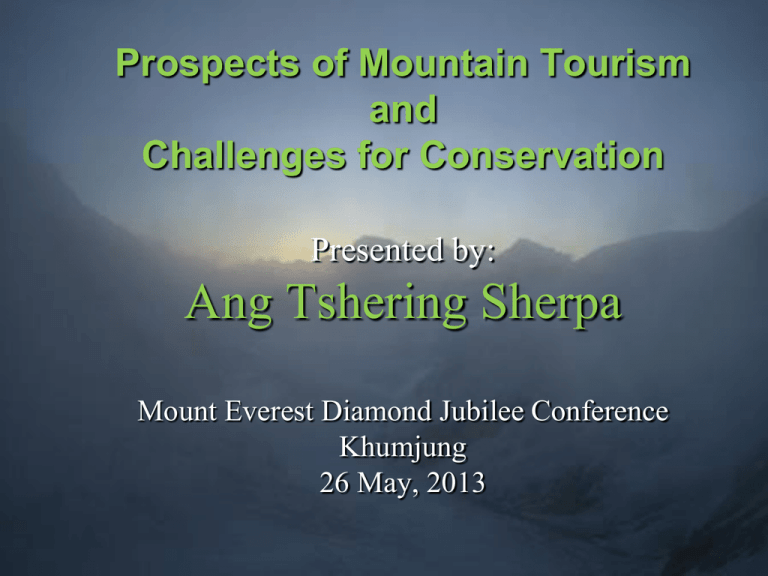
Prospects of Mountain Tourism and Challenges for Conservation Presented by: Ang Tshering Sherpa Mount Everest Diamond Jubilee Conference Khumjung 26 May, 2013 History of Mountaineering and Adventure Tourism in Nepal Mountaineering and adventure tourism are the most popular trend in alluring visitors to Nepal Milestones in the history of mountaineering: •1950 – Mt. Annapurna: First peak above 8000m scaled by Mourice Herzog & Luis Lachenal •1953 – Mt. Everest: Successful Ascent by Sir Edmund Hillary and Tenzing Norgay Sherpa •To commemorate their great achievement, we are here to celebrate Mt. Everest Diamond Jubilee Celebration Mecca of Mountaineering The dream of every mountaineer and adventurer. It is their ‘Mecca’! Nepal is the ultimate destination with: •Nepal identified 3310 peaks above 5500m with two categories: (a) Non-technical peaks 1397peaks,term as walking peaks such as Kalapathar (5550m)…. (b) Technical Peaks 1913 peaks, term as eligible climbing peaks including 1310 peaks above 6000m •This includes 16 peaks above 8000m peaks out of which 13 peaks above 8000m are permitted for mountaineering. •Only 326 peaks are opened for mountaineering expeditions • Still there are 1587 unclimbed peaks •Early mountaineers are the icons and symbol of courage, bravery and endurance…… Mt. Everest – 8,848m Mt. Kanchenjunga – 8,586m Mt. Lhotse – 8,516m Mt. Makalu – 8,463m Mt. Cho Oyu – 8,201m Mt. Dhaulagiri – 8,167m Mt. Manaslu – 8,163m Mt. Annapurna – 8,091m Sustainable Mountain Tourism How can mountain tourism pave a positive way towards sustainable development in remote regions? • Remigration of people back to their villages - reuniting families • Employment of women facilitates their empowerment • A market for traditional handicrafts • Aware that their income stream comes from protecting their cultural and natural environment • Sharing knowledge of culture, tradition, flora and fauna • Growth in education opportunities Sustainable Mountain Tourism What is needed to ensure that mountain tourism becomes or remains sustainable? • Attention for the economic, social, cultural and environmental dimensions of tourism • Government policies and strategies that ensure benefits are widely shared and the adverse impacts minimized • Community participation to funnel income directly into communities • The exquisite beauty of rural remote areas and genuine hospitality of mountain communities allowing for memorable holidays for the visitors Garbage on Everest • A common misconception that Everest is dirty • Everest was once known as the highest dump in the world. • Today it is recognized by climbers as one of the cleanest popular mountain in the world. • This is mainly due to greater awareness amongst climbers and operators and the efforts of various expeditions to clean the mountain eg. Eco Everest Expedition…. . Eco Everest Expedition and Cleaning Campaign • Eco friendly expedition organized every year since 2008 • A platform to draw global attention: raise awareness about the Impact of Global Warming and Climate Change in the Himalayas Glacier melting Glacial Lake Outburst Floods (GLOF) • • • • • • • • “Cash for Trash” by Asian Trekking: - more than 15,200 kilos of old garbage - 750 kilos of human waste - 5 dead bodies Sponsors of “Cash for Trash” Asian Trekking contribution - NRs. 3,09,30,000: The North Face Contribution - NRs. 8,00,000: Reinhold Messner contribution - NRs. 7,70,000: ===================== Approximate total expenses - NRs. 3,25,00,000: Use of highly successful alternative energy solutions: e.g. parabolic solar cookers, solar energies for lighting and the SteriPENs for water purification Eco Everest Expedition 2008 “CASH FOR TRASH” program A program which offers cash in exchange of garbage to Sherpas who bring down garbage from Mt. Everest •Endorsed by ICIMOD, UNEP •Sponsored by Asian Trekking Eco Everest Expedition 2009 “CASH FOR TRASH” program •6000 kgs of garbage in 2009 including wreckage parts of Italian Army Helicopter crashed in 1973 between Camp I and C II. •Sponsored by Asian Trekking and The North Face Eco Everest Expedition 2010 HIGH ALTITUDE CLEAN UP • Collected 1000 Kgs from 6500m and above • Invited and involved all Sherpas and climbers for this “Cash for Trash” program • Brought down 5000 Kgs from Camp 2 and below • Sponsored by Asian Trekking, The North Face and R. Messner Eco Everest Diamond Jubilee Celebration Expedition 2013 “CASH FOR TRASH” program •700 kgs of garbage as of yet including a rotar blade and landing gear of Italian army helicopter that crashed at camp 2 in 1973 •200 kgs of human waste •Sponsored by Asian Trekking Taking the climate change message to the top of the world Breaking his own record, Apa Sherpa after his summit of Mt. Everest in 2010. Apa Sherpa on the top of Mt. Everest for the 21st time in this year’s spring. Encourage climbers to climb in eco-sensitive manner. Dawa Steven Shepra with a Parabolic Solar Cooker (PSC) to the summit to create international attention and awareness on environmentally friendly technologies. Sherpas using PSC for cooking food Dawa S. Sherpa demonstrating the use of Restop Bag A small, but very significant beginning….. Alternative energy solutions: RESTOP BAGS • Human waste is contained and converted into environmentally friendly waste • Very useful in preventing improper human waste disposal Alternative energy solutions: SteriPENs • The SteriPEN uses ultraviolet (UV) light to destroy waterborne microbes • It is up to 160 times faster than chemicals and weights less than 225 g (8 ounces) with batteries. Alternative energy solutions: PARABOLIC SOLAR COOKER • Solar energy used to boil water • It weighs 28 kilos • A large PSC could boil 10 litres of water every 35 minutes, although almost twice as slow in comparison to a gas cooker, it is ample for cooking, washing and laundry. • On a normal sunny day it was possible to boiled 90 litres of water. The Road Ahead Nepal government needs to focus its efforts on: – – – – – – – – – – – – – – – – – improving infrastructure and mountain waste management Streamlining bureaucracy to make it more convenient to obtain permits Reduce permit fees to less popular peaks to promote them Strictly monitor environmental impacts Run regular clean up campaigns Remove the “one-team, one liaison officer” rule Ensure law and order in the remote mountain districts Improve health services and infrastructures in tourist areas Improve transport management and infrastructure, e.g. improve airports (blacktops) Supply clean water and sanitary facilities Immediate rescue provisions Assure political stability (i.e. no more strikes, protests, closures…. Provide tourist information centers at popular tourism hubs Diversify ‘tourism products’ Strengthen the national flag carrier (Nepal Airlines Corporation) Make mandatory to use toilet bags (Restop bags) on the mountains Encourage and inspire to use alternative energy instead of fossil fuel The Road Ahead Similarly, trekking and expedition operators need to: - Invest in training our staff Provide good quality equipment Prioritize safety over success Involve and encourage all staffs for clean up and to bring down garbage, debris and human waste from the mountain for proper disposal Be uncompromising on service quality and not sacrifice quality service for price Promote mountains in remote areas (even though they are less profitable and are logistically complex) Climbers and trekkers play the biggest role! … and must act responsibly: - They must put safety over success Help others in need Do not steal or use other climbers’ equipment and gear without permission Honor the “leave no trace” mentality Respect the local customs & cultures Follow the rules and laws of the host country Prepare well and hire adequate manpower to support the expedition or trek (as conditions are becoming more challenging in the Himalaya) The Road Ahead Role of NMA, TAAN, HRA, NARA and Associations Role of Local Stake Holders - Impact of Climate Change and Global Warming.. - Climate Changes is making a big differences on the mountain, especially it is causing more frequent avalanches and rock falls… - The whole mountains are undergoing drastic changes….. - Another problem is the fact that climbing Mt. Everest and other 8000m peaks are more and more mixed climbing with more rock exposure. The Road Ahead • Proposal of Rescue Cell: – As it is becoming clear that climbing in the Himalaya is going to become more and more dangerous and technical as time goes on, so we have conceived the idea of RESCUE CELL – A local team of highly trained, fully equipped and experienced rescue personnel, which always remains acclimatized, that will be able to immediately dispatch and respond to emergencies in the mountains – However, Nepal will need the technical and financial support of all UIAA member federations and government to make this project a reality. • If we all commit to work together on these ideals, I am sure that Nepal could become the best mountaineering destination in the world. This is very important for Nepal as it would go a long way in helping to eradicate poverty in our mountains. • Tourism: Nepal’s most important industry, income and employment generator and key to develop the remote areas • In our collective interest to increase the number of visitors to Nepal and thus formulate appropriate policies that facilitate the tourism industry and at the same time does not compromise the safety and security of the visitors. I am very deeply involved and committed to this vision. Pride of Our Mountains • Our knowledge of mountain geography and ecologies allows us to be highly influential witness to the climate change in our time and to extend that influence beyond the mountain communities to every one around us. • Our mountains are our heritage, glory, pride and the future of our nation. • Mountain areas need conservation and sustainable development for the present and posterity. • Mountains are gift from mother nature which we need to respect and protect them…. • And with this very goal we should all commit and join hands to play a vital role by creating awareness for conservation and carrying out various developmental activities with the participation of local people. Save the Himalayas for ourselves and our children • Saving the Himalayas means saving ourselves and our future generations: the Himalayas are the Water Tower for 1.4 billion people in South Asia (quarter of the world’s population) • As per some scientist and environmentalists by 50 year time, all white snow peaks and glaciers will melt away and transform huge glacial lakes which will pose great threat to the people living below. • If the Water Tower is empty, it will no longer be just an environmental problem but it will create humanitarian crisis and political problem on a scale never seen before. • So Let’s THINK Sustainably, WORK together and ACT now! THANK YOU Ang Tshering Sherpa Chairman, Asian Trekking (P) Ltd, Honorary Member of International Mountaineering and Climbing Federation (UIAA) Member of National Tourism Council, Nepal, IP President of Nepal Mountaineering Association and IPP of UAAA–Asian Mountaineering and Climbing Federation www.asian-trekking.com E-mail: angtshering@asian-trekking.com
